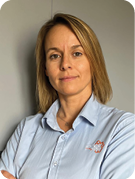Rock Products Interviews Julia Georgi of Price Bee About Process Improvement, Workforce Issues and Pricing Technology.
By Mark S. Kuhar
Sales process improvement and digitization are fast becoming necessary in our industry, how did you come to specialize in this area and what particular roles have you had that qualify you as an expert in this area?
For the past 15 years I have been helping improve the B2B sales process and customer experience across various industries, starting as a pricing project leader at Heidelberg Cement headquarters, then switching to strategy consulting at Strategy& (the global strategy consulting team at PwC) and ending my exciting corporate career at the large distributor of electrical equipment, Rexel.
The reason I believe my corporate career has ended is because throughout my experience I have identified that sales strategy cannot be executed without adequate software. Meaning that strategic thinkers can have the best idea on how to increase margins, but if salespeople on the ground are only armed with outdated Excels the result will not be as expected. Therefore one can only do that much from inside the company.

My mission today is to create more alignment between sales strategy and execution using sales software that is adequate for our industry. Not sure that it qualifies me as an expert, but I do have a vision on how things can be changed and I continuously get encouraged by Price Bee users to achieve this vision.
As an industry, our typical employee profile has been male dominated, and one of the biggest challenges our industry faces is an aging workforce. How does the affect the drive for higher sales performance?
It is hard for me to say if this male-dominated industry would be more successful with more women in sales. In general, diversity is beneficial for everyone but it has to make sense to our customers too.
Workforce aging context is actually quite different in every country and even in every city. For example, I have recently interviewed concrete and aggregates sales managers in Paris and they struggle to hire and to retain sales force, as younger people in Europe now tend to change jobs every three years. Clearly in this context we may deal with salespeople with very little industry knowledge that may frustrate clients and result in many lost bids. However, this generation is very sales-process driven. They are easily onboarded in all company software, like CRM, pricing and quoting systems, and use them in no time.
Employees with decades of industry experience in general can be considered as reliable, well connected and very loyal to the company. Indeed they are a bit more reluctant to change, but from my experience with little persuasion most of them will end up doing the right thing.
So the issue really is that we need to acknowledge this trend today and build software for the future.
The aggregates industry uses applications such as Excel for many tasks, from quoting to dispatch and everything in between. What are the advantages to the sales process of utilizing cloud-based applications instead?
Excel or GoogleSheet is great for a smaller business or a process that does not require frequent updates. It is cheap, flexible and if you know how to use it can pretty much support any business process like price or cost analysis, forecasting, sales pipeline review or even quotation. But as the business database and the number of transactions grow, Excel quickly hits its limitations.
Cloud applications are perfect for instant processing of large amounts of data and sharing it within the team and also with other connected applications. It is simply much quicker, more consistent and in a way more reliable for the company because it drives the process standard for all users.
Pricing has been a hot topic over the last two years, with inflation running at record levels and input costs for aggregates producers skyrocketing. How do you implement a price strategy and keep that strategy relevant in such turbulent times?
The most important in my view, is to ensure that salespeople are responsible for parts of the strategy and understand how their day-to-day bidding and quoting practices contribute to the overall picture. With every quote they make they should know if it is good or bad for pricing. Once this level of understanding is established we can start talking about a more analytical approach to pricing driven by the information from the ground.
How does the size of the company impact the effectiveness of the sales function?
Any size company can be effective in sales. However, from my own observation very small sales teams are naturally much more effective than larger teams because the future revenue of the company directly depends on the actions of a few people. Plus in smaller teams everyone works together in the same location and has an advantage of understanding end-to-end sales processes (for example from quote to cash). Larger teams require more advanced management, instant information sharing and sales process standardization across team members.
Julia, you have worked on the aggregates sales process in many different countries, including small, medium and large companies. Are there any similarities that stand out for you in this spread, and are there any differences that are worth noting?
First of all, with the exception of markets that export aggregates, like Norway, or rely on resellers, like in Melbourne, aggregates businesses are predominantly local. This means that good reputation and customer proximity are a must for any aggregates producer. I think this part is universal.
Another similarity is obviously sales cycles composed of seasonal bids and annual contracts. Proportion of bids is different, but pretty much everywhere in the world we can see some portion of annual agreements and some portion of projects that need to be quoted.

With bids come all sorts of other similarities – multi-bidder projects, cancellation, reopening and partial wins of those bids, price escalations for long projects, etc. My favorite similarity though is that 95% of salespeople I meet hate to set quote or bid as lost, but I think it is a topic for another article.
When it comes to pricing, you state in your promotional materials that Price Bee can achieve a remarkable 6% to 9% revenue increase for an aggregates producer, not changing products or client base. That is an extremely high number, how is this possible?
It is truly impressive how much sales teams can achieve with reasonable pricing strategy and good implementation. We need to accept that from a pricing software perspective the context our industry is in is quite deplorable. So when we put in place some simple company-wide methodologies like cost plus pricing or consistent discounting based on customer size, the results are almost immediate.
You use a number of different methodologies when looking to unlock additional profitability. The Customer Attractiveness Matrix, Pricing Self-Assessment and Pricing Diagnostic to name a few. Is there any particular methodology that brings higher revenue the fastest, and which one of the methodologies is your favorite?
It is a tricky question because the level of pricing maturity of the company will determine what methodologies can be applied. Also it is not a methodology that delivers the revenue increase, but the team. So when we choose methodologies we need to be very careful not to over complicate and help teams to transition to a next level pricing.
For aggregates, there are two methodologies that easily resonate with everyone and I generally see delivering faster mindshift change.
The first one is pricing for smaller clients. The notion of a small client depends on the market and can vary from 500 to 5,000 tons per year. Once we define a small size group range with a client’s team, we can then compare prices among different groups. Sales teams easily buy into the concept of price differentiators between larger and smaller clients as well as agree with the need to have more discipline around price setting and quoting. Those are small and easy wins from revenue increase perspective, but they serve as a basis of further pricing transformation.
My second favorite is Customer Attractiveness Matrix – it is a customer benchmark approach which is co-developed with a client. Together we design six to nine sales and pricing indicators and, thanks to the scoring, calculate how good each customer is for the business. Compared to the first approach, this one is harder to build and to explain but it is a true eye opener for key account managers.
You have mentioned that as an industry, Customer Relationship Management (CRM) is poorly adopted generally. Why is this? And if CRM is not used effectively, why would any other sales digital offering be any different?
One of the core features of the CRM is prospecting, lead generation and opportunity management. Today our industry is not that dynamic in terms of customer leads and when it comes to project opportunities aggregates salespeople often step into the play at the bidding stage. That is how quote and pricing become core sales processes to our salespeople, but standard CRM packages simply do not have industry specific set up to facilitate quotation. That is why at this stage it seems obvious that Configure, Price, Quote solutions like Price Bee that were specifically designed for aggregates are more useful to day-to-day sales.
But let’s not mix apples with oranges. Those are two systems that overlap somewhere but cover different processes. Plus, there are some hybrid systems on the market as well.
The main thing to keep in mind is that things change. With the new generation of salespeople arriving to the aggregates industry we shall expect much faster adoption of all sales-process-related tools.
For more information go to https://price-bee.com.
